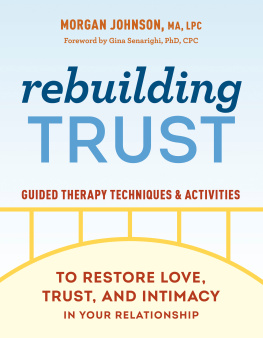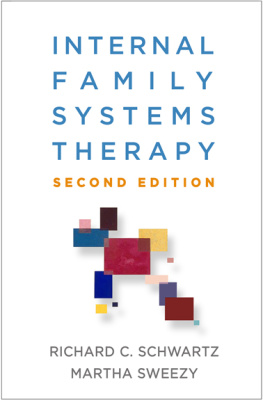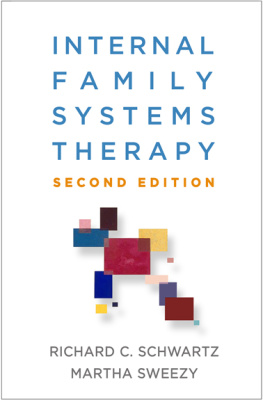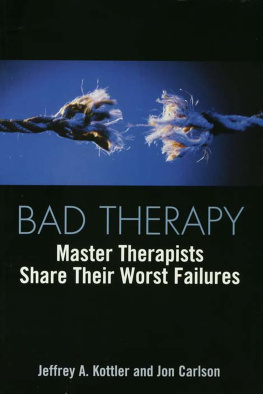I am deeply grateful to Dick Schwartz for creating such a brilliant method of therapy and working so hard to get it known around the world. IFS has changed my life and the lives of so many of my clients and students.
I appreciate the participants in my advanced IFS Classes and professional IFS Classes for helping me to deepen my understanding of this material as I taught it to them.
I received feedback that improved this book from Bonnie Weiss, Howard Ditkoff (www.systemsthinker.com), Katrin Kirojood, Roseanne Keefe, Jean-Pierre Marceau, Diana Kirigin, Dayal Mirchandani , Frank Lindemann, Esther Michelson, Riox Rheigh Frosher, Ingemar Fransson, Hal Morris, and David Burkhard.
Kira Freed has done a thorough job of editing and proofreading the entire work and laying out the books interior, including producing all the graphics for the book. Robert Henry converted it to the Kindle format. Jeannene Chase Langfords creative eye is always available for striking book cover design. My virtual assistant, Mary Jane Stern, has been continually in the background helping with innumerable tasks.
Introduction
My book Self-Therapy is a manual for IFS (Internal Family Systems Therapy). It has helped countless people resolve their psychological issues, as I have discovered from the many emails I receive from people all over the world telling me what a difference the book (and IFS) has made in their lives.
Self-Therapy teaches you how to work on yourself using IFS and how to do IFS peer counseling with a friend. It also gives therapists a thorough grounding in the basics of IFS and how to use it effectively with their clients. Since Self-Therapy was published in 2009, it has sold nearly 25,000 copies, and the sales are still as strong as ever. This is a testament not only to the quality of the book but also to the effectiveness and ease of use of IFS.
IFS is a powerful form of individual therapy developed by Richard Schwartz, PhD, that has been spreading rapidly around the U.S. and the world, especially since 2005. It is user-friendly, spiritually oriented, and very effective in working with trauma as well as a wide variety of other psychological issues. Schwartz is the founder of the Center for Self Leadership, which offers professional trainings in IFS. See www.selfleadership.org for information about these trainings and other aspects of IFS.
Self-Therapy is an introduction to IFS, and many important topics couldnt be included. I decided to write this sequel to Self-Therapy , which includes techniques and insights not in the first book along with much other content that I have learned about IFS in the years since I originally wrote Self-Therapy . That book was based on the IFS Basic Course and the Exiles Course that I have taught for many years. Since Self-Therapy was published, I have also been teaching advanced IFS courses for both professionals and the general public. These courses form the basis for this book.
A few of the chapters in this book are taken from two professional books of mine Negotiating for Self-Leadership in IFS and Resolving Inner Conflict . I felt that it was important to make the insights from those books available to everyone.
Once I started writing this book, I realized that there was more material than could fit into one volume. So Self-Therapy, Vol. 2 will be followed by further volumes in the Self-Therapy Series . I am excited about bringing this advanced information about IFS to the world.
Some of the topics in this book (and the rest of the Self-Therapy Series ) are taught in the IFS trainings offered by the Center for Self-Leadership, and some I have developed myself. Some of the topics are a standard part of IFS, some are extensions of IFS, and some are applications of IFS to certain psychological issues.
Chapter 1 discusses the importance of tracking your parts and taking notes on your sessions and shows how to do this. Chapter 2 deals with the important question of when to switch target parts and when to stay with the one you have chosen. Chapter 3 introduces the distinction between managers and firefighters, which are the two types of protectors in IFS. Chapters 4 and 5 deal with polarizationsinner conflicts between parts. They present a detailed, step-by-step process for resolving these conflicts. Chapter 6 discusses how to update your protectors so they understand your current adult capabilities and will therefore relax and cooperate with you. Chapter 7 shows how to negotiate with a protector to allow you to lead from Self and behave in a healthy manner in a difficult situation that is coming up soon in your life. Chapter 8 deals with Self-like partsparts that believe they are the Self and therefore get in the way of the IFS processand explains how to recognize and deal with them.
How to Use This Book
This book will be useful for both professionals and the general public. In order to reach both audiences, I have taken the following approach. The book is written for the general reader who wants to work on him- or herself using IFS. All the material will also be useful to therapists who want to use IFS with their clients. In addition, in various places in the book, I have added comments that are directed specifically to therapists; these are in sidebars titled Therapist Note .
Since this book is a sequel to Self-Therapy , I assume you have either read Self-Therapy or you have learned that material in another way, perhaps by taking the IFS Level 1 Professional Training. Therefore, this book doesnt present the basics of IFS. It assumes you know them and proceeds from there. To refresh your understanding of Self-Therapy before reading this book, read over the Help Sheets in Appendix A. If that isnt enough for you to feel up-to-date on the concepts in Self-Therapy , I recommend that you review that book before reading this one.
There are experiential exercises throughout the book so you can practice the IFS techniques that you are learning. I recommend that you do them, preferably with a friend, so you learn how the concepts actually work for you.
In this book. I occasionally use the Pattern System to show the relationships between types of parts. The Pattern System is a systematic, comprehensive way of understanding and diagnosing your personality that I have developed. See Appendix C for an introduction to the Pattern System.
Chapter 1
Tracking Your Sessions and Parts
I recommend that you spend some time right after each IFS session taking notes about what happened in the session and also keeping track of the different parts that emerged. This is useful for a number of reasons.













